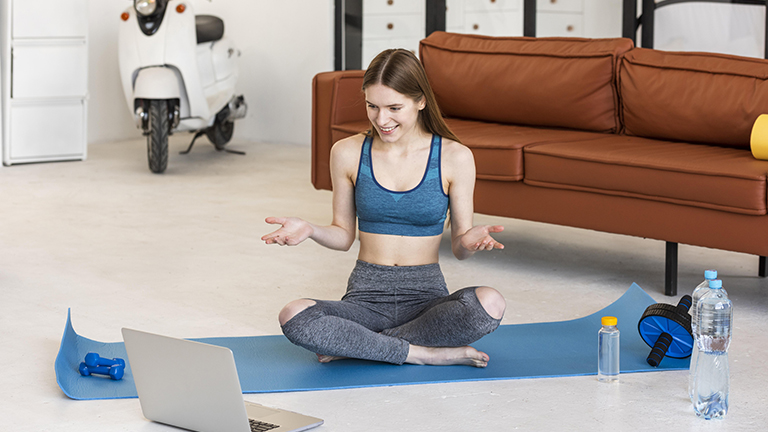Meditation for Beginners at Home: Meditating at home can be a simple but worthwhile practice to help alleviate stress, enhance focus, and contribute to emotional well-being through beginner-oriented guided experiences. With a few simple steps, an appropriate context, and some regular practice, anyone can take advantage of the capacities of being mindful and relaxed, if not even serene, in the ever-comforting and cozy atmosphere of home.
Introduction to Guided Meditation for Beginners
A guided meditation for beginners at home can be a powerful experience of mindfulness, relaxation, and mental clarity, even without a class setting. In a time when stress levels around the globe are increasing, meditation in the home can provide a simple and flexible way to develop emotional well-being and take stress reduction seriously. Following instructions step-by-step can help even the beginner achieve a calm mind in the comfort of his or her own home and develop mindfulness in support of a healthy lifestyle.
Benefits of Practising Meditation at Home
Reduces levels of anxiety and stress: Guided meditation decreases cortisol levels and relaxes the nervous system.
Enhances focus and mental clarity: Engaging in meditation regularly enhances focus and decisions making ability.
Increases emotional health: Meditation helps promote mindfulness, positive thinking, and self-compassion.
Enhances the quality of sleep: Sleep meditation practices can support insomnia, and relaxation practices.
Contributes to self-care routines: Meditation is an easy, and valuable practice that adds to your daily wellness practices.
Essential Tools and Home Meditation Setup
For beginners, creating a calming meditation space within the home is important. Here are some key features.
Quiet space: Choose a part of your home or a corner that is free of distractions.
Meditation cushion/chair: Provides comfort to support your body posture.
Soothing music or nature sounds: Helps you focus and relax.
Meditation apps or guided audio that you can listen to: A way to structure meditation and practice techniques such as body scan meditation and guided imagery.
Optional props: Eye masks, essential oil, or candle for enhancing the practice.
Step-by-Step Guide to Your First Meditation Session
Pick a time: Start with 5-10 minutes a day.
Choose a comfortable position: Sit upright on a cushion or chair with your back straight.
Close your eyes and breathe: Start with some deep breathing or other breathing relaxation techniques.
Use a guided video: Use an app or audio file to follow along with the meditation.
Observe thoughts non-judgmentally, allowing them to pass and re-centering the attention back on the breath.
End sessions slowly: Open your eyes, stretch, and note your experiences.
Common Challenges and How to Overcome Them
Restless or wandering mind: Try using your breath or guided imagery to guide your attention elsewhere.
Can’t sit still? Start off with a shorter practice, and gradually work your way up each week.
Feeling impatient? Understand that the benefits will take time, but they will begin to show with continuous practice.
Natural noise & distractions: Try using ear plugs, soft music, or meditation apps to help remain present with your attention.
Incorporating Meditation into Your Daily Routine
In order to fully benefit from your guided meditation practice , it is essential to develop consistency in your practice. Here is a beginner’s guide for implementing sustainable guided meditation:
Practice in the morning so you can start the day off in a relaxed state.
Lunchtime or the evening, can provide a good opportunity to do a quick mid-day pick-me-up meditation.
Tie these practices to your daily activities such as tea, reading, or journaling.
Set up an online app or a journal, so you have consistency with motivation, awareness of the process, and a way to see your progress over time.
Top Guided Meditation Resources and Apps
Resource/App
Best For
Features
Headspace
Beginners
Step-by-step guided meditation, mindfulness exercises, sleep sounds
Calm
Stress & Sleep
Guided meditations, breathing exercises, sleep stories, music
Insight Timer
Advanced & Beginners
Free guided meditations, courses, community support
Ten Percent Happier
Mental clarity
Practical meditation techniques, expert teachers, courses
Advanced Techniques for Deepening Your Practice
Body scan meditation is when you concentrate on separately on each area of your body.
Gently and progressively you can help increase relaxation.
Guided imagery is when you visualise a calming situation to distract from your anxiety.
Mindful movements could include gentle stretches or restorative yoga techniques.
Positive affirmations are when you state a phrase repeatedly, you can slowly build toward mental wellness.
Expert Opinion
Mindfulness expert Dr. Emma Roberts states, “One of the best ways to manage stress, increase your focus, and bolster emotional resilience, is to take advantage of guided meditation for beginners in your home. It’s true that even short and daily practices of meditation will have real and valuable impacts on mental health and well-being.” Experts agree that using practices of deep breathing in conjunction with audio guided meditations will also incorporate a more organised and appropriate meditation practice.
Frequently Asked Questions (FAQ)
Q1: When starting out, how long should beginners practice meditation at home?
Q2: Will doing a guided meditation help my anxiety?
Q3: Is there equipment I need for meditation at home?
Q4: When is a good time to meditate at home?
Q5: Can children engage with guided meditation? Yes, there are age-appropriate guided mediations and a variety mindfulness exercises that would be beneficial for children.
Conclusion: Embracing a Mindful Lifestyle
From the comfort of home, beginners can practice guided meditation to develop awareness, lower stress, and promote psychological health. Anyone can reap the benefits of meditation through a simple process of designating a space, listening to sessions, and making an effort to include them in daily life. With technology, music, and guided body scanning and imagery, you will be able to consciously create a calmer and healthier way of living.

